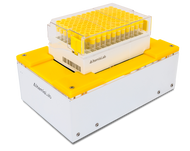What Is The Safest Way To Preserve Patient Samples For Long Term Storage?
Posted by Stellar Staff on 28th Mar 2022
Many people answer this question narrowly: By storing the sample in a durable cryogenic vial that can withstand being deep frozen for months on end.
In truth, safe storage of genetic material requires a comprehensive approach that begins from the moment of collection.
How samples are recorded, how samples are organized as well as how they are retrieved needs to be well thought out before the first sample is gathered.
Relatively inexpensive ways for tracking samples involve a combination of manual low-tech and some advanced tools.
Polypropylene cryovials stored in freezer boxes with numbered grids are the most affordable method. The contents of each vial can be recorded by hand in a lab notebook or electronically on a shared spreadsheet so everyone in the lab knows where each item is stored.


Newer ultra-low temperature freezers, like these from Haier Biomedical, have a built in inventory system that allows the location of each sample to be entered on the spot without having to jot down a note and transfer this information back at the workbench.

While this method suffices for the average research laboratory, biobanks and biorepositories, facilities that process and store huge numbers of one-of-a-kind patient samples, require a more efficient way to manage their inventories.
2D barcoded vials make it possible to track large numbers of samples quickly and accurately by using a barcode and reader system.

2D barcodes are fixed to the base of the tube which are then stored in racks with an opening at the bottom to expose the barcode to a flatbed barcode scanner or reader.

As samples are added to the rack, its contents and location are entered using a computer.
To retrieve a sample, the laboratory technician places an entire rack of 81, 96 or 100 barcoded tubes on the surface of the scanner and within seconds determines the location of the sample.
Some 2D barcoded cryovials are designed to store in SBS footprint racks which make them compatible for use with automated, robotic systems.
This makes is possible to locate, retrieve, position, uncap, extract, replace, re-cap and re-freeze samples without any human contact. This significantly reduces concerns for contamination and error.
AltemisLab’s catalog includes external thread, internal thread and septum capped vials with 2D barcodes on the base of the cryovial.
AltemisLab 2D cryovials are made with a dual injection process that permanently fuses the barcode to the cryovial making them inseparable.
Never lose track of a patient sample again.
Because sample security is critical, AltemisLab has tools to make handling as contact free as possible.
Like the semi-automatic capper and decapper “Switch” for handling an entire row of 2D cryovials as once – up to 12 at a time.
It not only looks cool - it IS cool.
There is no other adjustable handheld decapper that can do rows of 8 or rows of 12 with a simple switch.

Or thawing stations capable of thawing up to 1000 samples in nine minutes.
Biobanks and biorepositories can trust Stellar Scientific and Altemis Lab to protect their customer investments.

